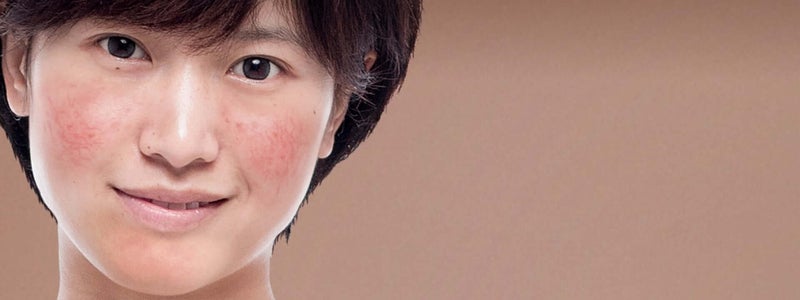MANAGE YOUR ROSACEA
How to manage rosacea skin


Living with rosacea

As a highly visible condition, rosacea is known to have a large emotional burden. Unfortunately, rosacea cannot be cured, however, appropriate rosacea treatment and lifestyle adjustments can help manage rosacea symptoms and improve quality of life.
Because of the way rosacea develops, if left untreated, it may worsen over time, so it is important to talk to a rosacea specialist as soon as possible to start your treatment journey.
Thanks to modern treatment approaches and with continued rosacea skin treatment, achieving clear skin with no rosacea features may be possible even for those with severe rosacea. Together with your dermatologist you should strive for no less.
Find out more about rosacea triggers and treatment options for rosacea below.
Identifying rosacea triggers
Have you identified the triggers that are making your rosacea signs and symptoms worse?
Rosacea can be triggered by a variety of factors. It’s different from person to person, but identifying rosacea triggers and the causes of your rosacea flare-ups will help you avoid them or find ways to manage them.
Keep a diary
Everyone with rosacea has different triggers and may even see their triggers change over time. Keep a diary and note down when a flare-up occurs and what you had been doing, eating, or drinking beforehand.
This should help you identify and keep track of your triggers so you have the option to reduce your contact with them should you want to try this.
Sun exposure
Extreme temperatures
Certain face skincare and cosmetic face products
Alcohol consumption
Intense exercise
Stress and emotional situations
Certain foods may trigger rosacea*
Book an appointment with your dermatologist today
Build your personalized rosacea appointment guide to take to your next visit with your family practitioner or dermatologist.

Rosacea skincare routine
Taking care of your rosacea skin
People living with rosacea have particularly sensitive skin that can react to certain ingredients. As everyone’s skin is different, it’s important to learn which skincare ingredients work for you, and which you should avoid, with the support of your dermatologist.
Our rosacea skincare guide provides information on how to properly clean and care for rosacea skin
Cleanse, moisturize and protect
Rosacea can make skin sensitive, so choose gentle, skin-friendly face products. Avoid using most soaps and facial cleansers as it can increase the pH of your skin, leading to irritation. Remember to use lukewarm water and never rub or scrub your skin to avoid irritating your rosacea.
Choose fragrance-free skincare products where possible and sunscreen with a Sun Protection Factor (SPF) of 30 or higher to help protect your skin.
Keep your skin hydrated
Drink plenty of water and use a humidifier during dry winter months.
Read your product ingredients and remember, less is more
Say no to additives: avoid skincare products containing alcohol, including after-shave lotions, fragrances and other skin-irritating ingredients.
Choose fragrance-free and irritant-free face product.
Avoid overheating your skin
Use lukewarm water instead of steaming hot in your baths or showers. Avoid alternating hot and cold baths to avoid “flushes”, i.e. sudden reddening of the skin.
Choose soft fabrics
Cleanse your skin with natural fibres, such as cotton and silk to help reduce skin irritation. Avoid wool.
When drying your skin, gentle dabbing is enough – avoid vigorous towelling!
Protect your skin from the sun
UV radiation is particularly hard on your skin. Therefore, try to avoid direct sunlight, and apply sunscreen with SPF 30 daily (even in winter and when the sky is cloudy!). Remember, try to choose a sensitive skin-friendly sunscreen, avoiding ingredients and fragrances that may irritate your skin and cause additional redness.
Rosacea and makeup
Finding the right makeup for your skin can be challenging but here are some tips to consider when it comes to rosacea and makeup.
If you have sensitive rosacea skin, avoid greasy/oily makeup if possible
Make sure that your makeup contains a low fat/oil content. Irritant ingredients and fragrances should also be avoided. Look out for the word “non-comedogenic” when buying. These products are formulated to cause fewer pore blockages and breakouts.
Less is more
When it comes to covering redness, the motto “more is more” doesn’t always apply and may result in a cake-y, mask-like appearance. Apply the makeup in a spot in the middle of the face and then gently work it outwards into the skin by dabbing or wiping. A clean makeup sponge works best for this and may be gentler on your skin than a makeup brush, which could cause irritation. Take care not to press or rub too hard to avoid causing additional redness.
Powder and cream blushes
Mineral powder blushes and cream blushes are available but should be applied sparingly with an antibacterial brush. When choosing a cream blush ensure that is is formulated for sensitive skin.
Concealer
Choose a product that best matches your skin tone, contains no irritating ingredients and is oil-free.
References
American Academy of Dermatology Association. How to Prevent Rosacea Flare-Ups. Available at https://www.aad.org/public/diseases/rosacea/triggers/prevent. Last accessed. July 2022; American Academy of Dermatology Association. Rosacea Skin Care Tips. Available at: https://www.aad.org/public/diseases/rosacea/triggers/tips. Last accessed: July 2022; American Academy of Dermatology Association. Triggers Could Be Causing Your Rosacea Flare-Ups. Available at: https://www.aad.org/ public/diseases/rosacea/triggers/find. Last accessed: July 2022; DermNet NZ. Rosacea: Symptoms, Causes, and Management. 2022. Available at: https://dermnetnz.org/topics/rosacea. Last accessed: July 2022; Huynh TT. Am Health Drug Benefits. 2013;6(6):348-354; National Rosacea Society. Makeup For Rosacea. Available at: https://www.rosacea.org/patients/makeup-for-rosacea. Last accessed July 2022; Pharmacy Times. Coping with Rosacea: A Guide from Triggers to Treatments. 2011. Available at: https://www.pharmacytimes.com/view/-coping-with-rosacea-a- guide-from-triggers-to-treatments. Last accessed: July 2022; Schaller M, et al. Br J Dermatol. 2017;176(2):465-471; Tan J, et al. Br J Dermatol. 2017;176: 431-438; Tan J, et al. The BMJ Hosted Content 2018. Rosacea: Beyond the visible. Available at: https://hosted.bmj.com/rosaceabeyondthevisible. Last accessed: July 2022.